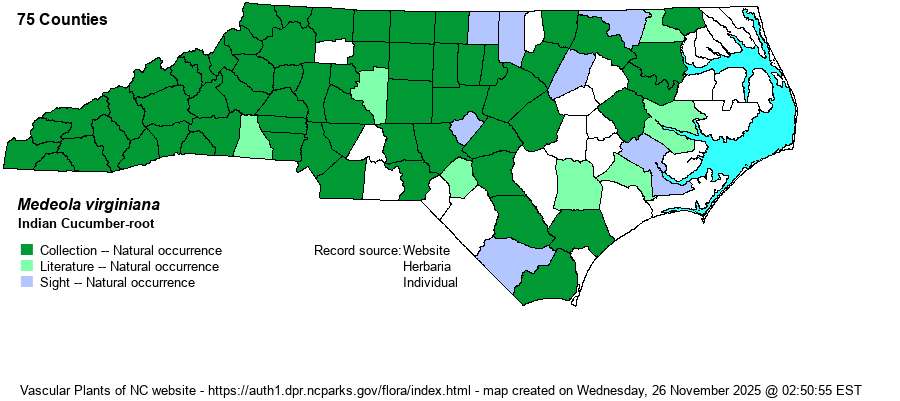| Author | L. | |
| Distribution | Throughout the Mountains and Piedmont, and nearly throughout the western two-thirds of the Coastal Plain. Seemingly absent from the eastern portions, with no records yet east of Gates, Bertie, and Craven counties. Of spotty occurrence in the southeastern counties and Sandhills proper.
This is a widespread lily of Eastern North America, from Que., Ont., and MN south to the FL Panhandle and eastern LA. | |
| Abundance | Common in the Mountains and foothills; fairly common in the remainder of the Piedmont. Generally uncommon in the eastern two-thirds of the Coastal Plain, but rare in the southeastern corner of the state. Essentially absent in the far eastern counties. | |
| Habitat | This species occurs in a variety of moist forested habitats, generally over acidic soils. It is most often found in Mesic Mixed Hardwood Forests, or near wooded creeks, but it also is present in bottomlands, wooded seepages, and other damp and shaded ground. | |
| Phenology | Blooms from mid-April into mid-June, and fruits in September and October. | |
| Identification | This is a monotypic genus, being the only member of the genus Medeola. Thus, it looks like no other when in bloom or fruit; however, young plants could be confused with a few other species. When at full height, with the inflorescence, it reaches about 15-20 inches tall. It has two whorls of leaves; the one at the middle of the stem has about 7-9 generally elliptical leaves about 2 inches long, whereas the upper whorl, of three elliptical leaves, is at the top of the stem. Dangling below this upper whorl are the 3-6 small greenish flowers, each about 1/3-inch across. In the fall, the bases of the upper whorl leaves turn a deep red, and the dark purple to black berries when ripe are borne in an erect position above this whorl. However, immature plants have only the lower whorl, and at that stage can look a bit like Lilium michauxii, Isotria verticillata, or the extremely rare I. medeoloides. However, the latter two have broad and rather soft/fleshy stems, as does Lilium to an extent, and that lily also has somewhat thicker leaves that are typically obovate. The stem of Medeola is thin and quite solid and "wiry". This species also tends to grow in small clusters, more so than the others, which often grow just singly. Most biologists are quite familiar with this unique species, and many a forest walk will produce them, particularly in the western half of the state. | |
| Taxonomic Comments | None
| |
| Other Common Name(s) | Indian Cucumber | |
| State Rank | S5 | |
| Global Rank | G5 | |
| State Status | | |
| US Status | | |
| USACE-agcp | FACU link |
| USACE-emp | FAC link |

